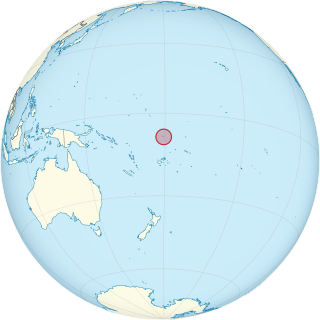| Tuvaluan | |
|---|---|
| Te Ggana Tuuvalu | |
| Native to | Tuvalu, Fiji, Kiribati, Nauru, New Zealand |
Native speakers | 11,000 in Tuvalu (2015)[1] 2,000 in New Zealand (2013 census)[1] |
| Latin script | |
| Official status | |
Official language in | |
| Language codes | |
| ISO 639-2 | tvl |
| ISO 639-3 | tvl |
| Glottolog | tuva1244 |
| ELP | Tuvaluan |
| IETF | tvl-TV |
 Location of Tuvalu, where Tuvaluan is spoken | |
 Tuvaluan is classified as Definitely Endangered by the UNESCO Atlas of the World's Languages in Danger | |
| Part of a series on the |
| Culture of Tuvalu |
|---|
 |
| People |
| Languages |
| Cuisine |
| Religion |
| Art |
| Music |
| Sport |
Tuvaluan (/ˌtuːvəˈluːən/),[2] often called Tuvalu, is a Polynesian language closely related to the Ellicean group spoken in Tuvalu. It is more or less distantly related to all other Polynesian languages, such as Hawaiian, Māori, Tahitian, Samoan, Tokelauan and Tongan, and most closely related to the languages spoken on the Polynesian Outliers in Micronesia and Northern and Central Melanesia. Tuvaluan has borrowed considerably from Samoan, the language of Christian missionaries in the late 19th and early 20th centuries.[3][4]
The population of Tuvalu is approximately 10,645 people (2017 Mini Census),[5] but there are estimated to be more than 13,000 Tuvaluan speakers worldwide. In 2015 it was estimated that more than 3,500 Tuvaluans live in New Zealand, with about half that number born in New Zealand and 65 percent of the Tuvaluan community in New Zealand is able to speak Tuvaluan.[6]
- ^ a b Tuvaluan at Ethnologue (25th ed., 2022)

- ^ Bauer, Laurie (2007). The Linguistics Student's Handbook. Edinburgh.
{{cite book}}: CS1 maint: location missing publisher (link) - ^ Ager, Simon. "Tuvaluan (Te 'gana Tūvalu)". Omniglot. Retrieved 6 November 2012.
- ^ Munro, D. (1996). "The Covenant Makers: Islander Missionaries in the Pacific". In Munro, D.; Thornley, A. (eds.). Samoan Pastors in Tuvalu, 1865-1899. Suva, Fiji, Pacific Theological College and the University of the South Pacific. pp. 124–157.
- ^ Ministry of Education and Sports; Ministry of Finance and Economic Development; United Nations System in the Pacific Islands (April 2013). "Tuvalu: Millennium Development Goal Acceleration Framework – Improving Quality of Education" (PDF). Archived (PDF) from the original on 13 February 2014. Retrieved 13 October 2013.
- ^ "Tuvalu Language Week kicks off today". TV3. MediaWorks TV. 27 September 2015. Archived from the original on 28 September 2015. Retrieved 27 September 2015.